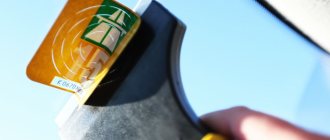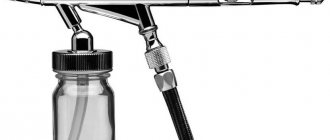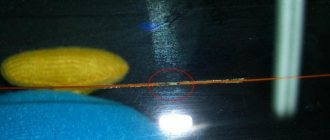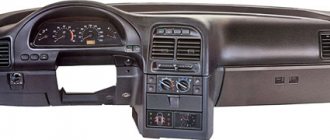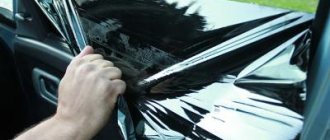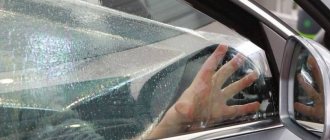Car window tinting is a rather complex technological process in which the windows are darkened with a special tinting film or sprayed or simply inserted colored glass. Many car enthusiasts are wondering how to remove old tinting from a car window and how to apply a new one using improvised means. Therefore, we will try to help them figure out how this is done.
Reasons for removing film
Peeling off the tint film is a very labor-intensive process that needs to be approached no less seriously than gluing it. So the removal methods will largely depend on the reason why you need to remove the old tint. Because a relatively freshly applied film is much easier to remove than an old one. And so let’s get acquainted with the most common reasons for its removal.
Reasons for removing film:
- If you notice that the film has begun to fade, peel off, or some defects have formed , for example, air bubbles, or it has simply changed its color , then it is clear that there is no point in leaving it on the glass, because it has already lost its functions anyway and the appearance too. Basically, a change in color can occur when using non-metallic dyes in tinting, and the appearance of bubbles, in turn, is due to poor adhesion of the tinting to the window or poor-quality glue.
- If after purchasing a car you find that the film is too dark, then it also needs to be changed, since it may not meet the standards. The traffic rules state that glass tinting is allowed only within permissible standards, that is, the light transmittance of the windshield should not be lower than 75% , for all other glasses the lower limit is 70%. In addition, there may be a light-protecting strip no more than 15 centimeters wide on the windshield . If you are stopped on the road by traffic police officers and notice this violation, then you cannot avoid the corresponding sanctions in the form of a fine.
- Also, removing the tint is necessary if a chip or crack appears on the glass and you are going to fix it to prevent it from spreading further.
Is it allowed to tint headlights?
On motorist forums, the question often comes up about the attitude of regulatory authorities towards tinting car optics, because no one wants to break the law and pay a lot of money for a fine. Correct answer: you can, the rules do not prohibit applying tint to car optics.
As for the question of whether it's worth it, you won't get a clear answer. You will certainly be stopped and checked for violations - a tuned car attracts more attention. But if everything is within the limits of the law, then you will not be afraid of the road inspection and any inspection. If you don't have any violations, feel free to do what you need to do.
What are the methods for removing tint?
Of course, ideally, in order not to bother with removing the film, you can use a special service at a car service center. But the price has recently risen to the point of impossibility, so it’s easier to do everything yourself. Many car enthusiasts mistakenly think that it is very easy to remove the film on their own, and they are very mistaken. Because in order to do this efficiently, you need to know several important points, which will be discussed further.
Therefore, let's look at ways to remove tint film:
- Using heating with an industrial hair dryer or steam generator.
- No heating with soapy water.
- Using ammonia.
You can use any of these methods to remove film from your car windows.
The manufacturer of the tinting films also plays a very important role. Opinions differ about Chinese tinting; some say that it doesn’t come off well, while others say it doesn’t last at all. For example, according to consumer reviews, the quality of Chinese film is much worse than that of other manufacturers. Therefore, to the question of how to remove old Chinese tinting, the answer is obvious, it is much more difficult, longer in time and more fuss than with a regular one, especially if it is also ancient. In all other respects, you need to act according to the generally accepted algorithm.
Removing tint using heat
How can you remove old tint, you ask. In order to remove the old tint film, you must first prepare the necessary tools, such as: an industrial or household hair dryer , although for heating you can also use a steam generator or other household appliances that can emit heat (in some cases they even manage to heat with an iron).
When using an industrial hair dryer
It is advisable
not to overdo it so that the glass does not burst
or deform, and
the tint film does not melt
.
Removal using an industrial hair dryer
Removal using a steam generator
Precautionary measures must be taken when heating the film because later it cannot be removed so easily; you will have to scrape it off. Also, for safety reasons, we recommend removing all decorative elements.
With the help of a steam generator, the film can be removed much faster and with better quality , because hot steam is supplied to the nozzle under pressure. This allows you to not only remove the film, but also the adhesive layer. It should be noted that although this method is quite effective, it is not safe, since the steam generator operates at a very high temperature , which can threaten not only the glass, but also one’s own health.
Next, we will present more detailed instructions for removing the film using a hair dryer:
- First of all, you need to warm the film thoroughly so that it comes off the glass without much effort without leaving a layer of glue, although if it remains, it doesn’t matter, then it can be removed additionally, the main thing is that the film is peeled off with a blade.
Important! While the hair dryer is operating, you need to ensure that hot air does not hit the rubber and plastic parts of the interior, so as not to damage them.Self-removal of tinting from car glass
- The second important point when removing is the temperature regime, it should not be different, because a temperature difference can negatively affect the glass , as a result it will begin to crack, so it is better to carry out such work in the warm season. Experts recommend heating the glass to 40˚C ; it is at this temperature that the glue will become soft and the film will not melt.
- After warming up, you need to carefully pry the film around the edges with a knife, trying to remove it in this way; you need to act slowly, because glue particles may remain on the glass, which will subsequently need to be washed with detergents.
To understand more clearly how to remove old tint, you can watch the video instructions below.
Removing tint without heating
The question of how to remove old tint without a hair dryer is asked by those car enthusiasts who do not have such a tool. And their first mistake is the very idea that if the edges of the film have peeled off, then it will be much easier to remove it than in the opposite case. Sometimes the simplest thing you can do is simply pull on the protruding part of the tint, which will subsequently simply come off and leave no pieces of film behind for further removal, which will mean that the material that held it on the glass has simply dried out. To prevent this from happening, use dishwashing detergents , because they are probably found in every home. Also, in addition to the detergent, you will need a small sponge or rag; you need to use it to wipe away stains on the glass; you also need a blade or scraper to pry off the film.
If the film adheres well to the glass, then you can simply “cut it off” using a sharp blade.
In order to get rid of old tinting with soapy water, without using heating, you need to:
- Immediately prepare the detergent , which must first be diluted with a small amount of water (24-40 ml of detergent per 1 liter of water). The finished solution must be poured into a sprayer for more convenient use. You need to spray it directly on the inner edges of the film so that the layer gradually comes off the glass.
- After that, we begin to pry off the film with a blade, at a very sharp angle to the glass, trying not to damage it. If you pry a piece of film until you can pull its edge, then you can try to pull it together with slow movements, while it is best to moisten the place where the glue was with a warm solution. This procedure must be done several times, while allowing time for the film to peel off.
- After the surface is cleared of film, you need to apply detergent to it and use a rubber scraper to remove the glue , which has softened under the influence of the product. You need to thoroughly clean the entire surface so that no material remains on the glass.
- If there is still glue left on the surface, it is recommended to use a special tint remover. 646 solvent or acetone will cope well with this task .
- After using the products, you need to wipe the glass dry, preferably with a clean piece of cloth.
Detinting glass using ammonia
By using such a harmful substance as ammonia, you can easily cope with removing tinting in any condition, both old cracked and still in good condition, on the side window or stuck on the rear window with heating threads. This method of tinting the rear window using ammonia is often used by Americans, since it is the most reliable and can cope with the persistent adhesive of the highest quality tinting films.
Here's what you need for this:
- The surface must first be moistened with a soap solution, then with ammonia.
- Then you need to attach a small part of a plastic bag to it to collect garbage, onto which you also need to apply ammonia from a spray bottle. It is recommended to work in a respirator.
- Apply the same piece of polyethylene to the inside of the glass. After which you need to leave everything for a while to wait until the heat of the sun’s rays warms up the polyethylene. Under the influence of heat and ammonia, the film will begin to deform and peel off from the glass.
- Next, all that remains is to simply remove the film along with the plastic bag.
The disadvantage of this method is that it can only be used in sunny weather. As a rule, after removing the film, glue remains on the glass; it needs to be cleaned additionally, for example, using a soap solution and a blade. After all operations performed, it is advisable to wipe everything thoroughly with a napkin.
Step-by-step instructions for working with film yourself
Removing tinting from a rear window is a labor-intensive procedure if you don’t know the secrets that we will now share.
Heat removal
One easy way to quickly remove tint is to use a hair dryer.
Step-by-step steps for dismantling the film:
- Preparing the site. It is recommended to carry out the procedure in a heated garage. With strong temperature changes there is a risk of cracks forming. You should not warm up frozen or cold glass, or work outside in winter.
- Heat. The surface is heated with a hairdryer to a temperature of 40-50°C.
The surface is heated with a hairdryer to a temperature of 40-50°C
- Removing the tint film. One person heats the base, and the second person pulls the film over the edges, gradually tearing it off. If you are careful, you can remove the coating in one piece.
- Precautionary measures. It is important to ensure that hot air does not reach the interior elements or paintwork of the car. It is better to avoid long-term exposure to one area with a hair dryer.
In the absence of a construction hair dryer, it is possible to use a household hair dryer, but due to limited power, heating and removal are carried out in small areas. The method has one drawback - an assistant is required, since it will be difficult to complete the procedure alone.
Removing film without heating
An alternative method is to remove the film without heating. The procedure is easy to perform alone, but is labor-intensive and requires mandatory adherence to the algorithm.
The method is effective for film from Chinese manufacturers; the soap product will not take a high-quality American base; to remove it, you need to use a hairdryer.
Removal procedure:
- The car is washed thoroughly, the greatest attention should be paid to clean glass. The presence of contamination will reduce the effectiveness of the method; sometimes the procedure must be repeated.
- The edge is pryed off with a thin, non-sharp tool. You cannot cut the film directly on the glass.
- If the film has peeled off in a large piece, slowly remove it evenly.
- After removing the film, a cleaning solution is applied to the surface. Any substance with cleaning properties will do: soap solution, Fairy and the like.
After removing the film, a cleaning solution is applied to the surface
- Waiting 10-15 minutes is necessary for the remaining glue remaining after removing the tint to eat away.
- To remove the glue, soft rubber scrapers are used to carefully remove the remaining film.
- If stains still remain, use a cotton swab soaked in acetone. It is important to prevent solvent from getting on the rubber seals and interior. It is better to cover the door panel with a rag.
- After completing the dismantling, you should wash the glass with a special liquid for cleaning auto glass.
How to remove tinting from a rear window without damaging the heating
Removing the tint film on the side windows is much easier and faster than doing it on the rear, especially if it is heated. Therefore, we will pay special attention and tell you about the nuances of how to remove the tinting film from the rear window without damaging the heating, interior trim and decorative panels. Let's reveal a few tricks.
In most cases, rear windows are heated in the form of special thin threads. So when removing the film from the glass, there is no need to make sudden movements , because the heating elements can be damaged. Only heating and using a soap (alkaline) solution to avoid negative consequences when removing the film . Therefore, if you don’t have a hairdryer, just turn on the glass heating . Under the influence of heat, the glue will become softer and can be easily removed from the glass without damaging the heating filaments.
It is allowed to heat the glass with a hairdryer at temperatures above 0 degrees, otherwise it may burst. Therefore, it is not recommended to remove tinting in winter.
Another simple and reliable method to get rid of tinting on heated glass is to use the ammonia removal method (described above). Or even ordinary soapy water using cling film. But spraying water and gluing the film on top will delay the removal of the tint for a couple of days (this is exactly how long it takes for the water to penetrate behind the film and for it to come off).
As you can see, everything can be done with your own hands, if only you are attentive and careful with your vehicle. If you carry out all the actions strictly according to the instructions, then you will not damage anything in the car, but if this process still seems difficult for you, then it is better to turn to professionals, but then you will have to spend 2 - 3 thousand rubles.
Removing tint film from headlights
remove the film layer from headlights yourself using the same methods as from windows. If the tinting layer was applied using paints and varnishes, the algorithm of actions is somewhat different. The surface of the headlights needs to be sanded. To do this, use a grinding machine or sandpaper with an abrasive layer, first 2000, then 3000. The headlights are sanded until the tint is completely removed. Before starting work, you need to tape the joints of the headlights and adjacent surfaces with masking tape.
After reading the instructions and useful tips, you can choose the appropriate tint removal option for yourself. The main thing is to prepare the necessary tools and means in advance, be patient and carefully complete all the work.
There is also a video on how to properly remove tint.
How to remove remaining glue from glass
If you made some mistakes when removing the film, a sticky layer of glue may remain on the glass. To cope with it yourself, you need to try very hard.
It is strictly not recommended to remove the glue with a blade, because you can damage the glass; for this, use a spatula (spatula).
Therefore, next we will look at the instructions for removing the glue. To easily deal with glue residue on the glass surface after removing the tint, you need to know some important points :
- Water . With its help, you can soak the remaining glue, but if it sticks very well, then water may not help in this case.
- Solvents . This is a pretty good method, but quite dangerous. You should not use substances with high concentrations, for example, acetone, it is very aggressive to glass surfaces.
- Gasoline . Before applying to glass where glue remains, it should be diluted with water. Also, be careful not to create rainbow stains.
- Alcohol . The best of all methods and not so dangerous. It copes well with the adhesive surface and removes excess without harming the glass.
- Ammonia . Copes very well with repair (construction) glue. Removes tint along with glue, but you need to be careful and protect other surfaces of the car from ammonia. After removal, you need to wipe the glass well with alcohol.
Thus, you can remove the remaining glue from the glass after removing the tint film using a spatula, but before doing this, you must wet the areas with remaining glue with soap or another solution from the list presented.
Few people know, but glue residues, both from tinting and other stickers, can be easily removed with universal lubricant WD-40.
As you can see, the procedure for removing tint is not a simple procedure, so if the darkening of the film on the windows of your car is within acceptable limits and you would not like to regularly remove it for re-sticking, then we recommend following a few tips.
Errors during withdrawal
The work at first glance seems simple if you look at the actions of the masters. Many drivers think that they can remove the film by lifting it by the edge and sharply tearing it off. The operation is actually simple, but it requires skills. After all, the darkening must be removed completely so that no pieces of material or adhesive stains remain. There are several subtleties in this work, and incorrect actions can lead to replacement of glass and waste of money.
- Using sharp, hard objects: knives, scissors, which can scratch the glass.
- Use of acetone and chemicals containing it. This will cause the coating material to stick, dissolving the tinting layer. Aggressive liquids can damage rubber seals and body coating.
Removing tint yourself is a simple procedure if you prepare everything you need and follow the recommendations described.
How to care for tinted car windows
If you want the tint to serve you for a long time, then you need to follow some recommendations for its care.:
- not recommended to leave the car windows open for 5 days after tinting the windows .
- no need to wash the inside of the glass for up to 3 weeks after gluing the film; this is done so that the adhesive layer sticks well to the glass.
- Try not to touch the edges of the film on the glass so as not to damage them, so that later it does not start to peel off.
- After each wash, it is imperative to wipe the glass without leaving any water.
- When washing glass, do not use brushes to avoid damaging the tint.
- Do not use special detergents that contain ammonia .
- You can clean the film with any product suitable for hand washing only in the ratio of 30 grams of product per 1 liter of water.
Caring for tinted glass is simply necessary; if you do not pay special attention to this, your film will quickly become unusable and, as a result, it will need to be replaced, which will negatively affect your budget and nerve cells.
As you can see, the methods for removing tint films from car windows are quite different. And removing a tint film is no different from removing PVC film on a body. Therefore, in order not to harm your car, you need to be extremely careful when removing them. Also, when buying a film, you should pay attention not only to the cost, but also to its quality, because the service life and the difficulty of removing the tint will then depend on it.
What not to do
Many car enthusiasts do not consider it necessary to read how to remove old tint. They immediately get down to business, making serious mistakes. This negatively affects not only the appearance of the car, but also harms the glass.
Let's look at what not to do when removing tint:
Remove the film using available tools. There is a risk of scratching the glass. Then the driver will have to change it to a new one, spending a decent amount of money. Windshields are especially expensive. Thus, it is prohibited to use a knife, screwdrivers, scissors or other sharp objects to remove the coating.
The use of aggressive “chemistry” is another driver mistake. Such substances will not only “stick” the film to the glass even more strongly, but will also deform the window seal. Strong chemicals can also damage body paint.
Drivers believe that a sharp tug of the film will remove the coating from the glass in a couple of seconds. Firstly, the film may tear and it will be difficult to hook the corner. Secondly, improper removal guarantees the presence of a sticky layer on the glass.
The effectiveness of film removal depends on its properties and characteristics. For example, there is a mirror tint that contains a metal oxide. It is this that makes the film pliable. It is much easier to remove than a regular one.
Relevance
The service in question is offered in car repair shops, however, after the introduction of more stringent requirements for the light transmittance of car tint films, the cost for removing this material has increased slightly. These same requirements have forced many users to get rid of tinted windows, especially the windshield, front side windows and headlights. Therefore, in order to save money, they began to carry out this work themselves.
Many people removed the tint film in the simplest way, that is, they picked up the edge of the material with a sharp object and pulled it off. However, after this, fragments of film and glue remain on the glass. To completely clean your car glass, you can use any of the technologies described below: material removal with or without heating. Visual lessons on removing tint film can be found on the Internet in video format.
The nuances of do-it-yourself work
When removing tinting, various complications are possible, which you should know about in advance. The first and most common is the film breaking during removal, when the master tries to tear it off sharply or is generally sloppy. In this case, you should immediately stop dismantling the film and, picking up the end of the torn section, continue removing the main and torn parts simultaneously.
It should be remembered that the effectiveness of film removal also depends on some of its characteristics. In addition to thickness, features also exist when removing athermal and mirror films. The first is distinguished by the presence of an ultraviolet-absorbing layer, which prevents the interior from heating up when parked in the sun. It is recommended to remove such a film without using heat, since high temperatures can lead to the destruction of the protective layer and the appearance of “shagreen” on the surface, which will make it much more difficult to remove the coating.
Most often, those who roll up a car with an athermal can afford to take advantage of the removal services
Mirror tint film, on the contrary, is much easier to remove. This is due to the fact that the coating contains a thin layer of metal oxides that provide a mirror effect. These substances increase strength, and therefore the dismantling of such a film most often occurs without tearing. Afterwards, only a little pollination may remain, which can be easily washed or removed using commonplace compounds.
Pasting a reflective strip on the windshield
The tint strip must be cut along the roll with a small margin. Then wet the surface of the glass and place your workpiece on it with the adhesive layer facing out.
Make slits along the seals and remove excess tinting film.
Do not forget that you must use only special blades that do not leave scratches on the glass!
- Smooth out the pattern so that there are no horizontal folds - only vertical ones.
- Then, using a hairdryer and forcing, heat and smooth out the vertical folds.
The windshield is sensitive to temperature changes, so do not heat it up or cool it down suddenly!
- Moisten the workpiece, fold it in half and smooth it carefully so that there are no folds or wrinkles.
- Then, using a ruler and a knife, make notches at a distance of 10-12 centimeters from the top edge of the pattern.
Make notches as often as possible. Using this method you can make a reflective strip of any width. The width will depend on how far from the edge you make the notches.
- After this, remove the excess tint film.
- Then lay out the pattern along its entire length and use a ruler to cut the notches between each other (this process is clearly shown in the training video below).
When working with film when tinting windows, always place the adhesive layer and liner on yourself.
- After this, place the resulting workpiece again on the damp windshield from the outside.
- Wet and smooth the pattern and use the light from inside to make precise cuts.
To avoid gaps after applying the tint film, make a cut so that the film extends a few millimeters onto the opaque area of the glass.
Clean the glass and apply the film for tinting from the inside in the same way as in previous cases.
How to remove glue from tint
For many drivers, sticky tint stains are a big problem. They wonder how to remove them without damaging the glass or the car itself.
When removing tinting glue, you should not do it yourself, as this can lead to unpleasant consequences. Set a clear plan for what you will do. Follow this plan strictly.
Pattern of film for tinting car side windows
Before you start tinting your car windows, you need to cut out the tint film.
To do this, you need to determine where the adhesive layer is located - it is protected by a transparent liner. Always cut the film along the roll and make sure that the cut piece is a few centimeters larger than the glass.
- Moisten the outside of the glass and place a pre-cut piece of tint material on it with the liner facing toward you. The bottom of the film should be parallel to the outer horizontal window seal and overlap it by approximately one centimeter.
- Using a punch and a knife, make side vertical slits in the film so that you can then place the pattern over the vertical seal by about one centimeter.
- Next, having folded the bottom part of the pattern, lower the glass a little and, having secured the film along the upper edge of the glass, make a horizontal cut in it, and then give it its final shape.
Choosing a film for car window tinting
The tinting film market is so large that to review it, we wrote a separate article about films for tinting car windows.
We do not recommend buying cheap Chinese DIY kits; instead, we recommend purchasing only high-quality roll film for window tinting.
Also listen to the recommendations of sellers who sell tint films. From them you can purchase all the tools necessary for tinting windows.
Still, it is better to see once than to hear a hundred times. Therefore, we suggest watching a video tutorial on tinting car windows with your own hands, which is located at the bottom of this article.
And for better assimilation of the material, all stages of self-tinting windows are described below and can be used as a cheat sheet.
Materials and tools for tinting car windows
In the process of tinting your car windows yourself, you will need the following tools:
- Spray,
- Soft and hard forcing,
- Paper napkins,
- Sponge,
- Scraper,
- Ruler,
- Knife,
- Hair dryer.
To work with the tint film, use a water-soap solution prepared in the following proportion: 5 drops of washing shampoo per 1.5 liters of water. Mix the solution thoroughly (you can use the container of your spray bottle for this).
Before you start tinting, you should thoroughly clean the exterior of the glass using a prepared water-soap solution.
Tinting composition
This composition is intended directly for tinting glass. First, prepare a mixture of rosin with a 20% aqueous solution of sodium hydroxide (caustic soda NaOH). Rosin is dissolved to obtain a dark yellow liquid, which is filtered. Add a small amount of FeSO4 (ferrous sulfate) or FeCl3 (ferric chloride). As a result of the reaction, a red-brown precipitate should form - iron resinate, which is separated, washed with water, and dried.
Resinate is dissolved in one of the following compositions:
- pure gasoline;
- turpentine;
- petroleum ether;
- diethyl ether;
- carbon disulfide;
- hexane
The resulting solution is evenly applied to the glass. Use a spray bottle or brush. The window must be pre-prepared - cleaned, degreased, washed, dried.
The applied solution must dry. Then the glass is placed in an oven heated to 600°C for 5–10 minutes. A thin, durable brown film forms on the window.
To obtain other tinting colors, use the following compounds instead of ferric chloride:
- copper chloride gives green tints;
- cobalt chloride – blue-blue;
- chromium chloride – emerald-ruby;
- zinc chloride – milky white;
- Lead chloride is yellow.
The color saturation is regulated by different concentrations of metal salts and rosin. To find the right shade, you can experiment on a piece of glass.
Caustic soda is a substance of hazard class II. Therefore, work should be carried out in a well-ventilated area. To protect your eyes, it is mandatory to use chemical goggles. Hands are protected with rubber or rubberized fabric gloves, the body is protected with a rubberized suit or chemically resistant, vinyl-impregnated clothing.


